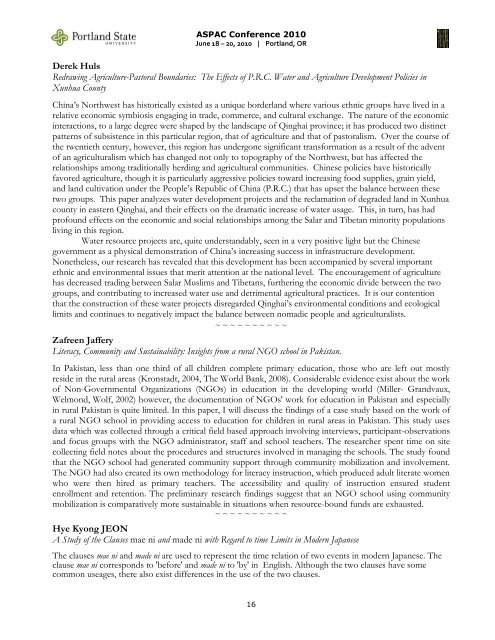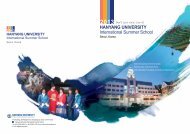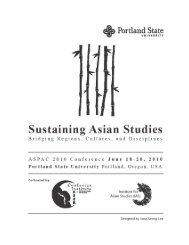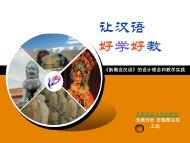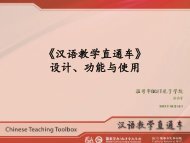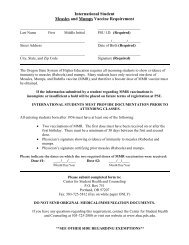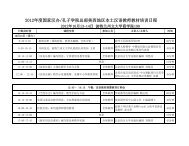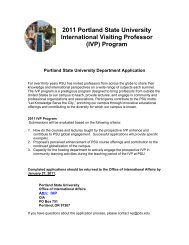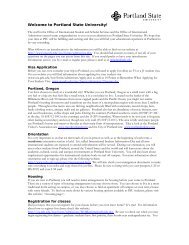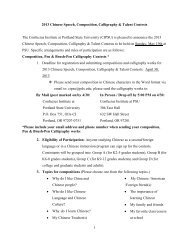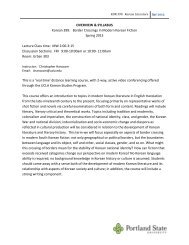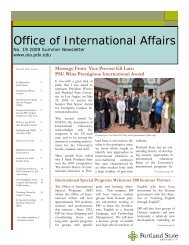ABSTRACTS - oia - Portland State University
ABSTRACTS - oia - Portland State University
ABSTRACTS - oia - Portland State University
You also want an ePaper? Increase the reach of your titles
YUMPU automatically turns print PDFs into web optimized ePapers that Google loves.
ASPAC Conference 2010<br />
June 18 – 20, 2010 | <strong>Portland</strong>, OR<br />
Derek Huls<br />
Redrawing Agriculture-Pastoral Boundaries: The Effects of P.R.C. Water and Agriculture Development Policies in<br />
Xunhua County<br />
China’s Northwest has historically existed as a unique borderland where various ethnic groups have lived in a<br />
relative economic symbiosis engaging in trade, commerce, and cultural exchange. The nature of the economic<br />
interactions, to a large degree were shaped by the landscape of Qinghai province; it has produced two distinct<br />
patterns of subsistence in this particular region, that of agriculture and that of pastoralism. Over the course of<br />
the twentieth century, however, this region has undergone significant transformation as a result of the advent<br />
of an agriculturalism which has changed not only to topography of the Northwest, but has affected the<br />
relationships among traditionally herding and agricultural communities. Chinese policies have historically<br />
favored agriculture, though it is particularly aggressive policies toward increasing food supplies, grain yield,<br />
and land cultivation under the People’s Republic of China (P.R.C.) that has upset the balance between these<br />
two groups. This paper analyzes water development projects and the reclamation of degraded land in Xunhua<br />
county in eastern Qinghai, and their effects on the dramatic increase of water usage. This, in turn, has had<br />
profound effects on the economic and social relationships among the Salar and Tibetan minority populations<br />
living in this region.<br />
Water resource projects are, quite understandably, seen in a very positive light but the Chinese<br />
government as a physical demonstration of China’s increasing success in infrastructure development.<br />
Nonetheless, our research has revealed that this development has been accompanied by several important<br />
ethnic and environmental issues that merit attention at the national level. The encouragement of agriculture<br />
has decreased trading between Salar Muslims and Tibetans, furthering the economic divide between the two<br />
groups, and contributing to increased water use and detrimental agricultural practices. It is our contention<br />
that the construction of these water projects disregarded Qinghai’s environmental conditions and ecological<br />
limits and continues to negatively impact the balance between nomadic people and agriculturalists.<br />
~ ~ ~ ~ ~ ~ ~ ~ ~ ~<br />
Zafreen Jaffery<br />
Literacy, Community and Sustainability: Insights from a rural NGO school in Pakistan.<br />
In Pakistan, less than one third of all children complete primary education, those who are left out mostly<br />
reside in the rural areas (Kronstadt, 2004, The World Bank, 2008). Considerable evidence exist about the work<br />
of Non-Governmental Organizations (NGOs) in education in the developing world (Miller- Grandvaux,<br />
Welmond, Wolf, 2002) however, the documentation of NGOs' work for education in Pakistan and especially<br />
in rural Pakistan is quite limited. In this paper, I will discuss the findings of a case study based on the work of<br />
a rural NGO school in providing access to education for children in rural areas in Pakistan. This study uses<br />
data which was collected through a critical field based approach involving interviews, participant-observations<br />
and focus groups with the NGO administrator, staff and school teachers. The researcher spent time on site<br />
collecting field notes about the procedures and structures involved in managing the schools. The study found<br />
that the NGO school had generated community support through community mobilization and involvement.<br />
The NGO had also created its own methodology for literacy instruction, which produced adult literate women<br />
who were then hired as primary teachers. The accessibility and quality of instruction ensured student<br />
enrollment and retention. The preliminary research findings suggest that an NGO school using community<br />
mobilization is comparatively more sustainable in situations when resource-bound funds are exhausted.<br />
~ ~ ~ ~ ~ ~ ~ ~ ~ ~<br />
Hye Kyong JEON<br />
A Study of the Clauses mae ni and made ni with Regard to time Limits in Modern Japanese<br />
The clauses mae ni and made ni are used to represent the time relation of two events in modern Japanese. The<br />
clause mae ni corresponds to 'before' and made ni to 'by' in English. Although the two clauses have some<br />
common useages, there also exist differences in the use of the two clauses.<br />
16


